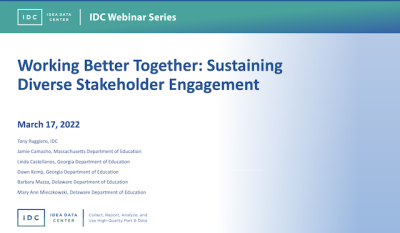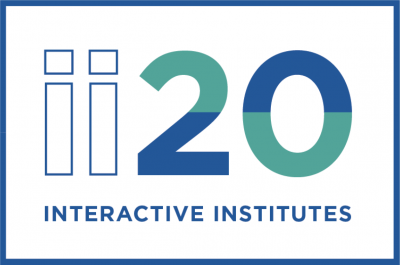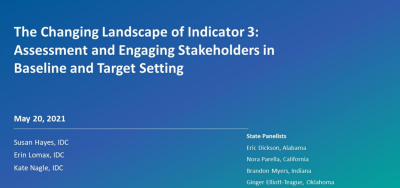Site Search
Results 1 - 7 of 14
-
Working Better Together: Sustaining Diverse Stakeholder Engagement
Join this webinar to learn state strategies for recruiting stakeholders including parents, sustaining their interest, and working effectively with them to improve outcomes for children and youth with disabilities and their families.
-
The Changing Landscape of Indicator 3: Assessment and Engaging Stakeholders in Baseline and Target Setting
During this webinar, we reviewed the changes to Indicator 3 of the Part B SPP/APR and took a deep dive into how some states are preparing and working with stakeholders to set baselines and targets for the indicator. State panelists addressed data quality concerns due to COVID-19 closures and reopenings, as well as the 2021 testing flexibilities and how they affect setting baselines and targets. Speakers presented strategies for identifying diverse stakeholders and presenting complex data to help stakeholders understand the data. In addition, state panelists revealed their plans for working with stakeholders, including the data they plan to share with stakeholders, how they plan to present these data, what input they will ask for, and how they plan to document ongoing stakeholder input.
Format: Quick Reference
Comprehensive IDC Part B Tool & Product ListThis resource is a list of IDC produced Part B tools and products arranged by topic area. The list provides a brief description and link to each tool or product. Users can quickly scan for useful tools and products to ensure that they have explored all of the many Part B available resources that IDC has produced.
Format: Quick Reference
FFY 2020–2025 SPP/APR Resources At-a-GlanceThe FFY 2020–2025 SPP/APR Resources At-a-Glance is a list of resources from OSEP and IDC that states can use to support their understanding and actions related to the FFY 2020–2025 Part B SPP/APR.
Format: Guides and Briefs
Building Your SPP/APR Stakeholder Engagement Plan: 10 Essential QuestionsBuilding Your SPP/APR Stakeholder Engagement Plan: 10 Essential Questions can help states develop and report on authentic and broad stakeholder engagement as required in the FFY 2020–2025 SPP/APR. This interactive resource guides states through 10 key questions they should be asking themselves as they build their stakeholder engagement plans. Each question provides detailed options to consider that will assist states in preparing to describe their engagement activities in their SPPs/APRs.
Format: Quick Reference
Navigating Uncharted Waters: Engaging Stakeholders in Part B Indicator 3 Baseline and Target SettingThis customizable resource includes a PowerPoint template and presentation notes that provide states with an overview of the Part B SPP/APR reporting changes to Indicator 3, which addresses participation and performance of children with individualize education programs (IEPs) on statewide assessments. The resource reviews the new requirements related to stakeholders, particularly parents, in the SPP/APR and implications for Indicator 3 and shares strategies for engaging stakeholders in the optional baseline and required target setting processes. States are able to customize the information in the PowerPoint to reflect their own contexts and to meet the needs of different audiences.
Format: Trainings
ii20 Session Presentations and HandoutsThe Interactive Institutes 2020 – Building and Sustaining a Culture of High-Quality Data provided opportunities for participants to take a deep dive into data quality topics to learn about data culture change. Participants were able to discover best practices to improve data collection, reporting, analysis, and use. They also engaged with peers and TA providers about trending data quality topics. Each session presented powerful ideas and actionable plans to improve work processes and data quality.








